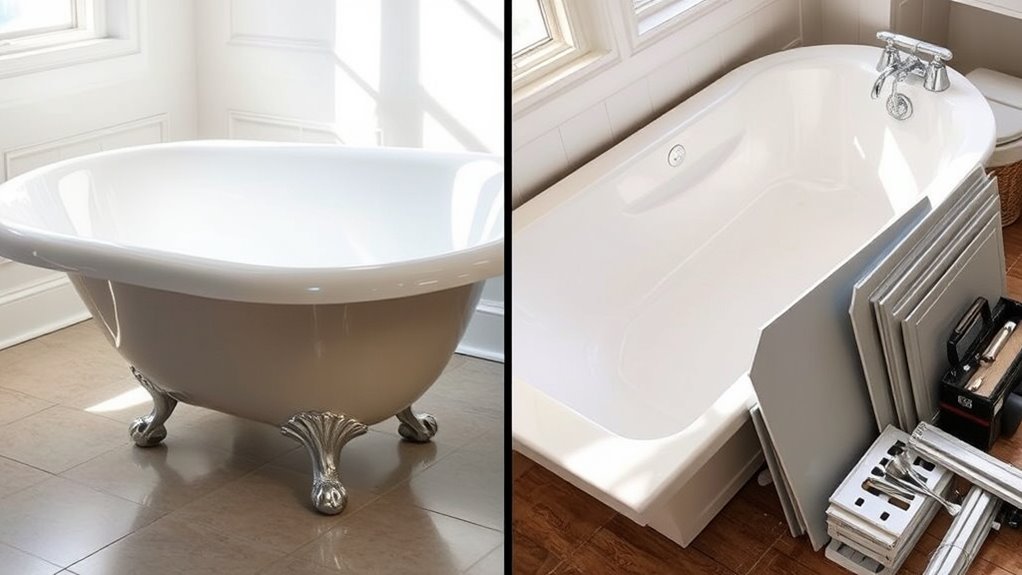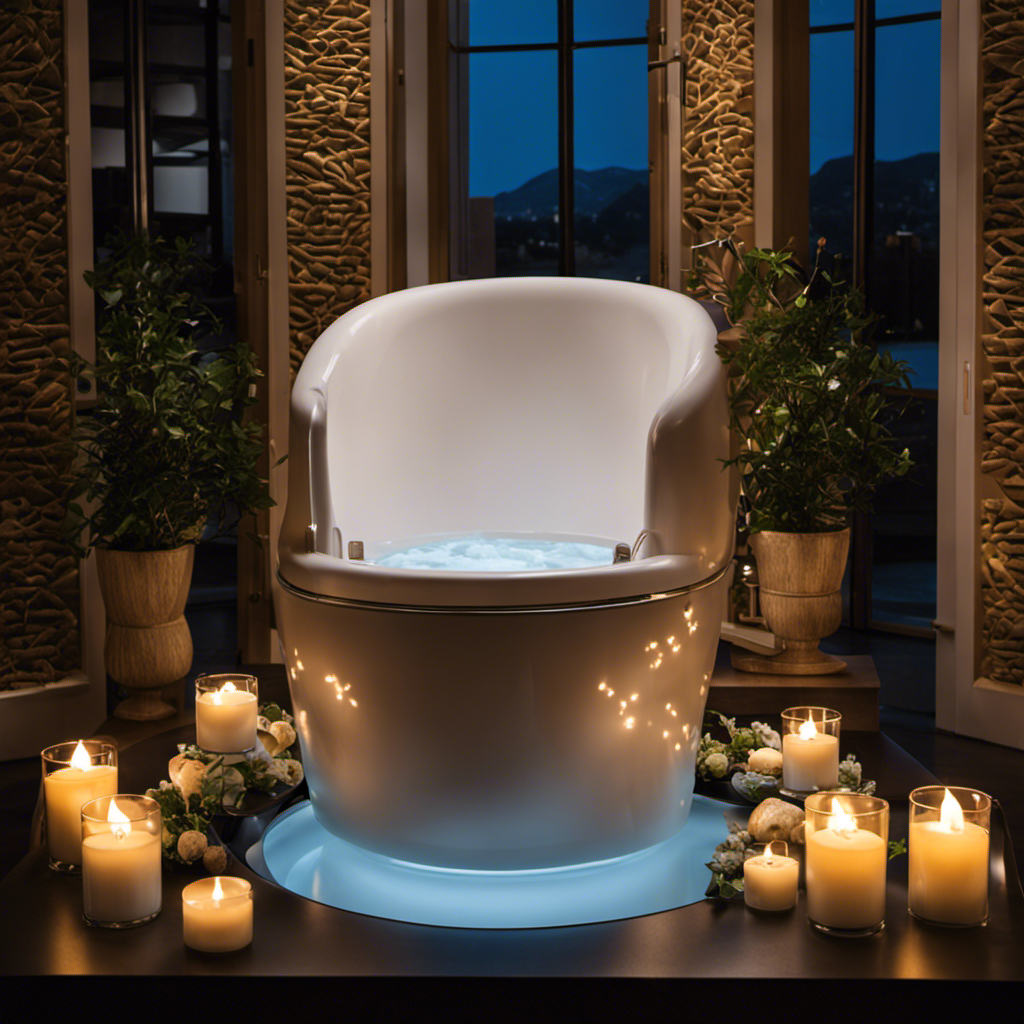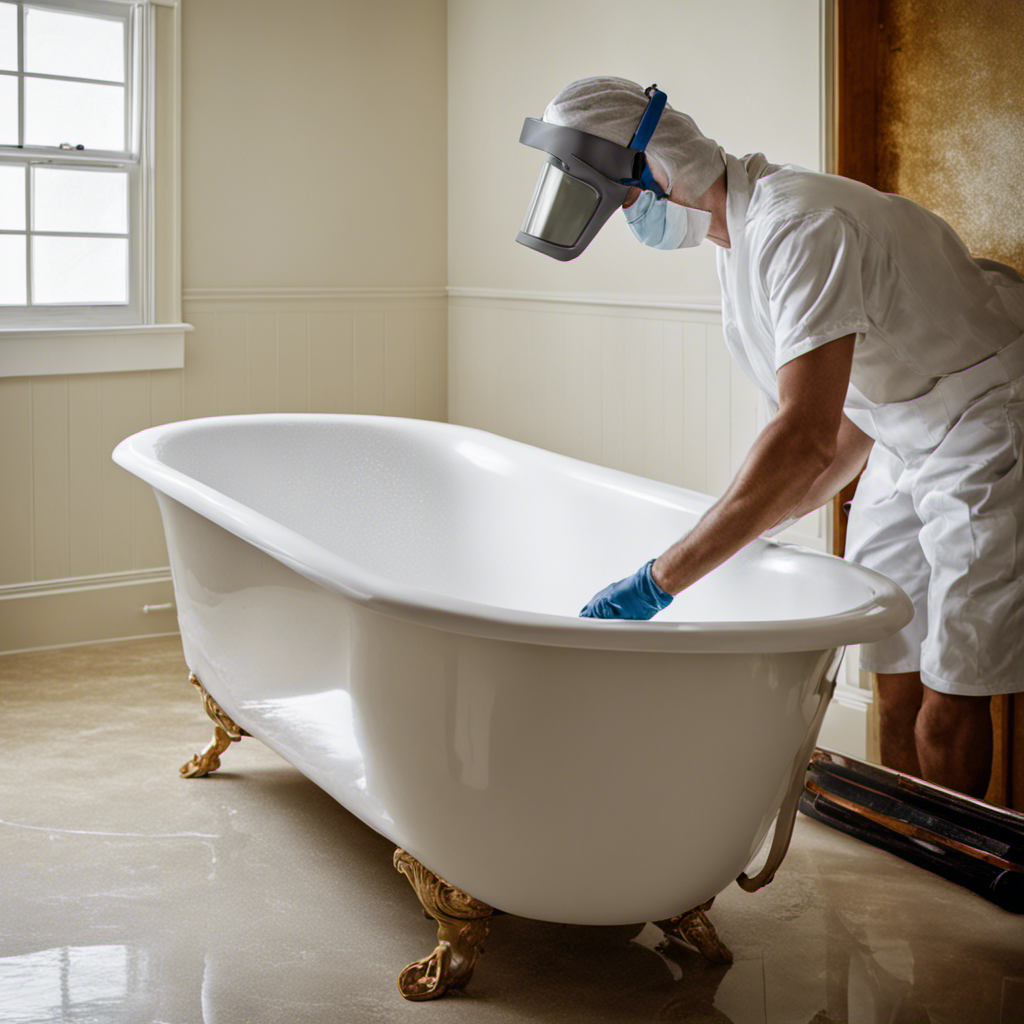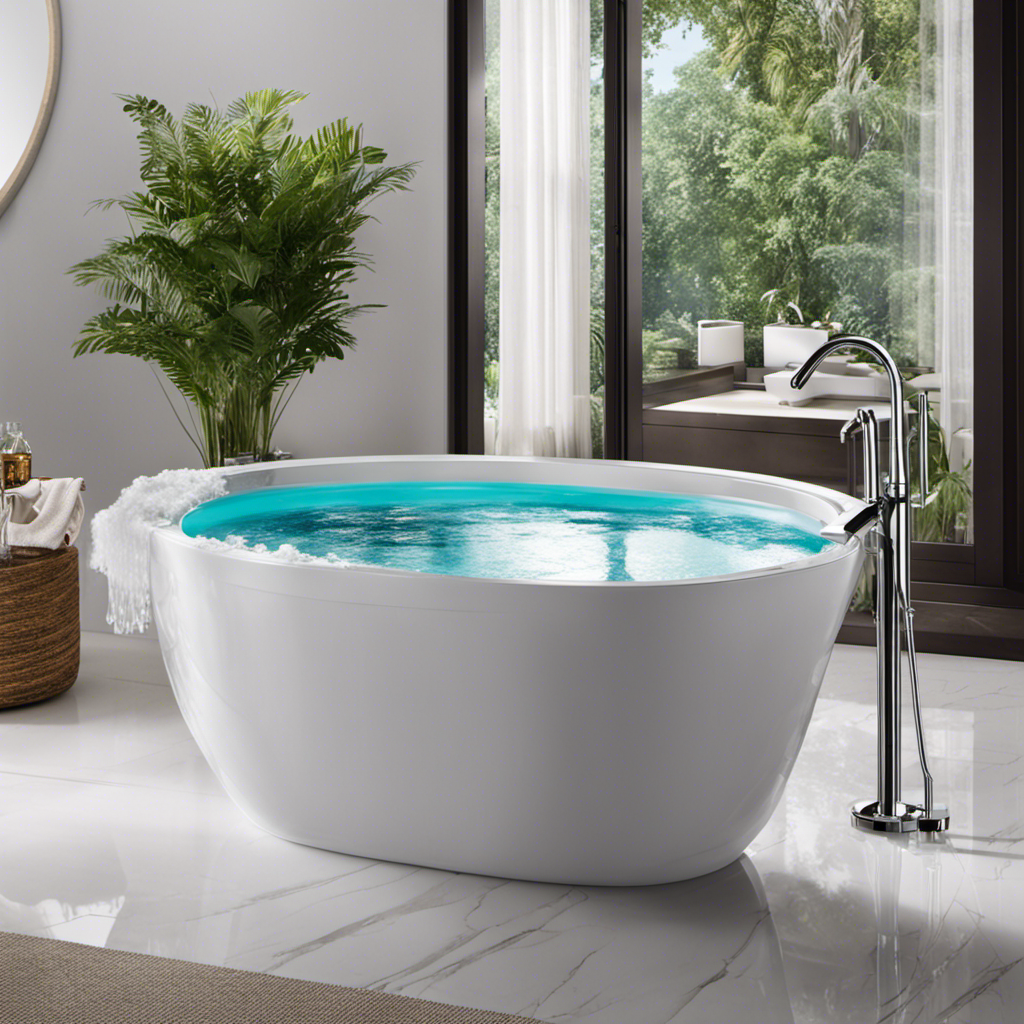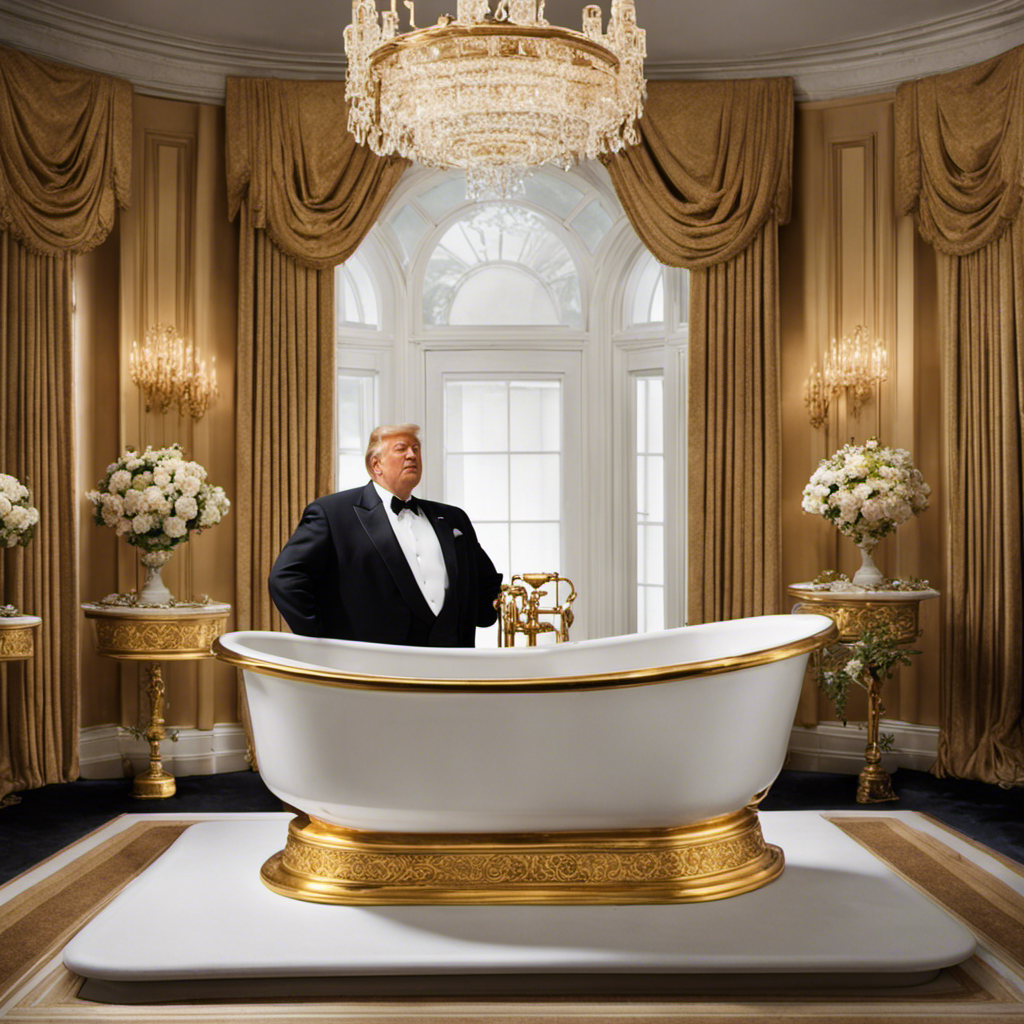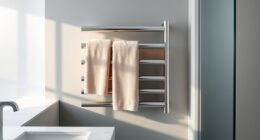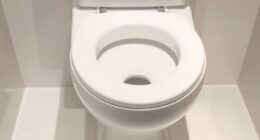When choosing between bathtub refinishing and replacement, you should consider your budget, how quickly you need it done, and long-term durability. Refinishing is typically cheaper, faster, and causes less disruption, making it ideal for minor updates. Replacement offers more customization and durability but takes more time and costs more. If you want a quick fix or cost-effective solution, refinishing is better; for a complete overhaul, consider replacing. To explore these options further, keep going.
Key Takeaways
- Cost and budget: Refinishing is generally cheaper and quicker than full replacement, with less disruption.
- Durability and longevity: New tubs often last longer and withstand wear better than refinished surfaces.
- Time and convenience: Refinishing can be completed within a day, while replacement may take several days.
- Aesthetic options: Replacement offers more customization and design upgrades, while refinishing restores existing style.
- Surface quality and maintenance: Refinishing improves appearance but may require upkeep; replacement can provide a more durable surface.
Cost Comparison and Budget Considerations

When deciding between refinishing or replacing your bathtub, understanding the cost differences is essential. Material costs play a significant role, with refinishing typically costing a fraction of replacement. Refinishing involves less expensive materials, such as specialized paints and coatings, which help keep costs low. On the other hand, replacing your tub requires purchasing a new unit, which varies widely depending on size, material, and style. Labor expenses also influence the overall cost. Refinishing usually incurs lower labor costs because it’s quicker and less invasive, often completed in a day. Replacing a bathtub involves more extensive work, including demolition, plumbing adjustments, and installation, leading to higher labor expenses. Budget wisely by considering both material costs and labor when making your decision.
Time and Convenience Factors
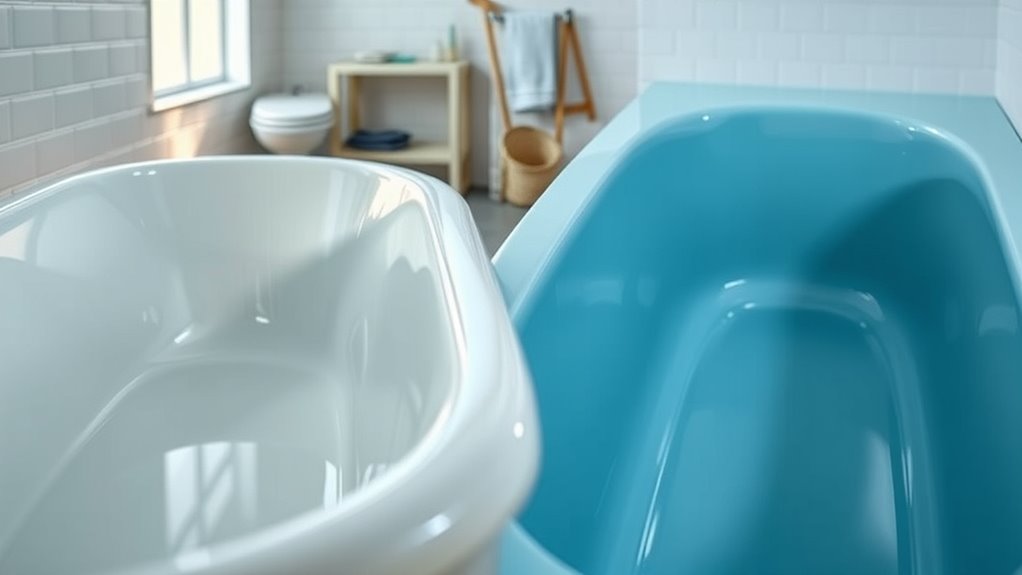
Choosing between refinishing and replacing your bathtub often hinges on time and convenience. Refinishing typically involves a quick installation process, often completed in a day or two, minimizing disruption to your routine. The cleanup effort is also minimal, as there’s little debris or heavy tools involved. Replacing a bathtub requires more time, usually several days, due to the removal and installation process, which can be messy and labor-intensive. You’ll need to clear the area and prepare for extensive cleanup afterward. If you value a swift turnaround with less hassle, refinishing offers a convenient solution. On the other hand, if you’re willing to invest more time to get a new tub, replacement might be worth the extra effort. Your schedule and desire for convenience should guide your decision. Additionally, understanding the differences in projector technology can help you make informed choices about upgrades or renovations in other areas of your home. Incorporating efficient planning can further streamline the process and reduce overall stress. Being aware of project timelines can also help set realistic expectations for your renovation projects.
Durability and Longevity

While quick installation and minimal mess are important, understanding how long your bathtub will last is equally vital. When comparing refinishing and replacement, consider the material resilience and wear resistance of each option. Refinishing typically involves coatings with good wear resistance but may degrade over time if not properly maintained. Replacement offers a more durable solution with a new tub built from resilient materials like acrylic or porcelain. To help you decide, consider these factors:
- Material quality and resilience
- Resistance to chipping, cracking, and staining
- How well the surface withstands daily use
- Maintenance requirements for longevity
- Expected lifespan based on material and craftsmanship
- Material durability is a key factor in determining how long your bathtub will remain functional and attractive, especially since some materials are more resistant to wear and damage over time. Additionally, wear resistance can vary significantly depending on the specific coating or material used in refinishing versus a new tub. Regular maintenance practices also play a crucial role in extending the lifespan of your chosen option. Moreover, understanding the long-term performance of each option can help you make a more informed decision about your bathroom renovation.
Aesthetic Options and Customization
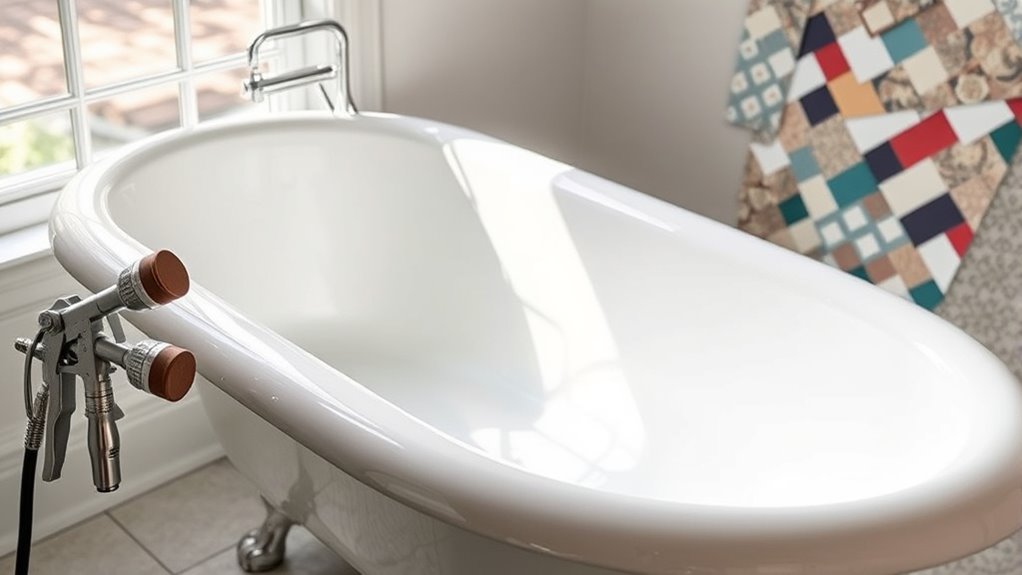
When choosing between refinishing and replacement, you can customize your bathtub’s look with a variety of colors and patterns. You also have options for a smooth or textured finish to match your style and preferences. These aesthetic choices let you create a bathroom that reflects your unique taste. Additionally, selecting finishes that complement your overall bathroom decor, such as farmhouse or vintage styles, can enhance the cohesive design harmony. Incorporating different aesthetic options like decorative accents or themed motifs can further personalize your space and elevate its visual appeal. Exploring various refinishing techniques allows you to achieve a distinctive and stylish bathroom environment. Furthermore, understanding the cybersecurity aspects involved in selecting reputable refinishing services can help protect your investment and personal information during the process.
Color and Pattern Choices
Color and pattern choices offer a wide range of options to customize your bathtub’s appearance, allowing you to match your bathroom’s overall style or create a bold focal point. With extensive color selection, you can opt for classic whites, modern grays, or vibrant hues that reflect your personality. Pattern variety also plays a key role, from solid finishes to intricate designs that add visual interest. These options give you the flexibility to tailor your bathtub’s look to your preferences. Consider how different colors and patterns can influence the room’s ambiance or complement existing decor. Additionally, color customization options enable you to select finishes like matte, glossy, or satin to achieve the desired aesthetic and texture. Knowing the entertainment support hours of various facilities can help you plan your visits accordingly, ensuring you don’t miss out on special events or extended hours. When choosing between refinishing and replacement, the variety of aesthetic options can significantly impact your decision, helping you achieve your perfect bathroom look. Moreover, understanding zodiac sign compatibility can sometimes inspire your design choices, reflecting your personal style and personality traits. Incorporating dream symbolism into your design can also add a meaningful touch that resonates with your personal beliefs.
Textured or Smooth Finish
Choosing between a textured or smooth finish lets you customize your bathtub’s appearance and tactile experience. A textured finish adds grip and a unique visual appeal, making it a good choice for safety and style. It can hide imperfections better and create a more rustic or artistic look. Conversely, a smooth finish offers a sleek, modern vibe that feels luxurious and easy to clean. It’s ideal if you prefer a minimalist aesthetic or want a surface that resists staining. When deciding, consider how you use your tub and your style preferences. Both options can be tailored to match your bathroom decor. Ultimately, your choice between a textured finish and a smooth finish depends on your desired look, safety needs, and maintenance preferences.
Impact on Bathroom Functionality
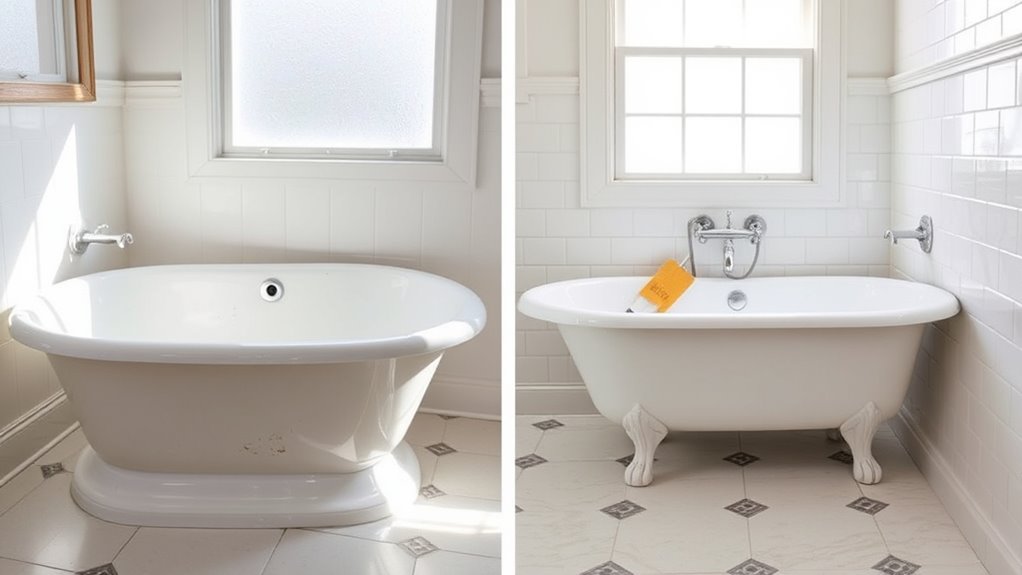
Refinishing your bathtub can markedly impact your bathroom’s functionality by restoring a smooth, durable surface that’s easier to clean and maintain. A refinished tub enhances bathtub ergonomics, making it more comfortable and safe to use. It can also improve water flow efficiency, reducing splash and pooling issues. Additionally, a well-refinished surface minimizes dirt buildup, cutting down cleaning time. Consider these factors:
- Improved grip and safety due to a non-slip surface
- Better water flow, reducing stagnation or drainage problems
- Enhanced comfort with a smoother, more ergonomic design
- Reduced maintenance time thanks to a resilient finish
- Increased overall usability, especially for those with mobility challenges
Refinishing isn’t just aesthetic; it directly impacts your daily bathroom experience by optimizing functionality and safety. Modern fixtures can further enhance your shower experience and overall bathroom efficiency. Additionally, choosing high-quality bathtub refinishing techniques ensures longer-lasting results and better performance over time.
Repair and Maintenance Needs
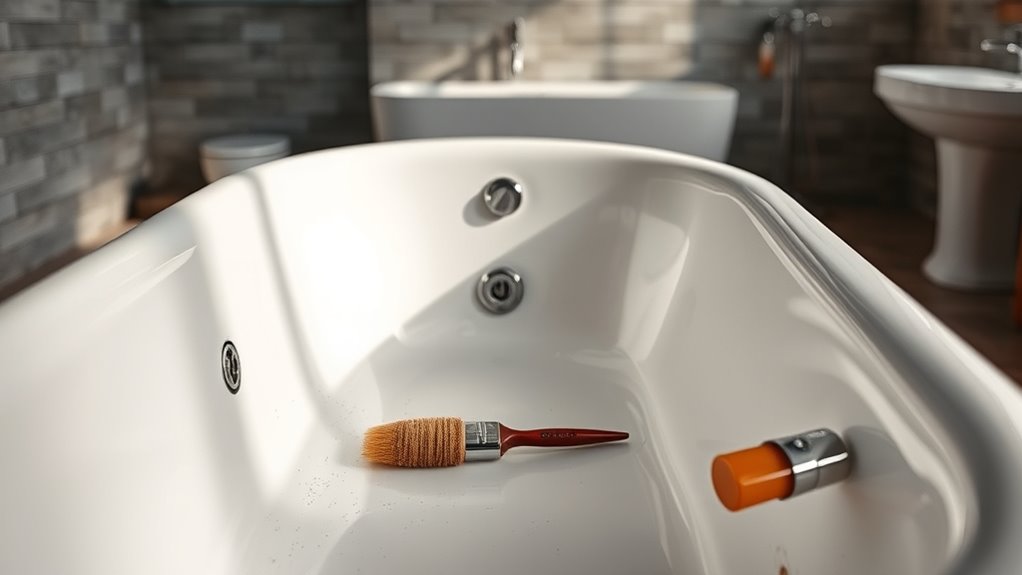
While bathtub refinishing can extend the life of your tub, it still requires ongoing repair and maintenance to keep it in ideal condition. Over time, cracks may develop, making crack repair necessary to prevent further damage and water leaks. Proper surface preparation is vital for maintaining the finish’s durability; this involves cleaning, sanding, and ensuring the surface is free of debris before applying any touch-ups. Regular inspections help identify issues early, so you can address them promptly. Although refinishing can reduce the frequency of repairs compared to replacement, it’s not maintenance-free. Keeping the surface smooth and repaired as needed ensures your bathtub stays attractive and functional for years. Proper upkeep preserves your investment and prolongs the refinished surface’s lifespan. Additionally, understanding relationships can help in managing the emotional aspects of home renovations, especially when coordinating with professionals or navigating decision-making processes.
Environmental Impact and Sustainability
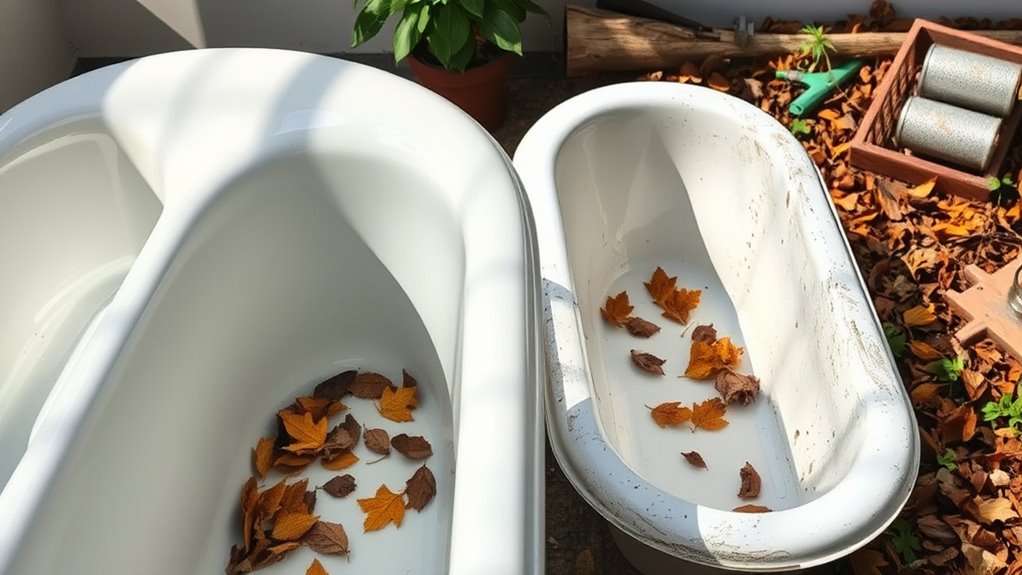
Bathtub refinishing typically has a lower environmental impact than replacement because it uses fewer materials and generates less waste. By opting for refinishing, you reduce the need for new materials and minimize landfill contributions. Eco-friendly materials are often used in the process, such as low-VOC paints and sealants, which lessen chemical emissions. Additionally, refinishing offers recyclability options for existing fixtures, further reducing waste.
Consider these factors:
- Use of eco-friendly materials minimizes harmful chemicals
- Less manufacturing energy consumption
- Recyclability options extend the lifespan of existing fixtures
- Reduced waste from fewer discarded tubs
- Lower transportation emissions due to fewer new materials needed
This approach supports sustainability without sacrificing functionality.
Scope of Work and Disruption
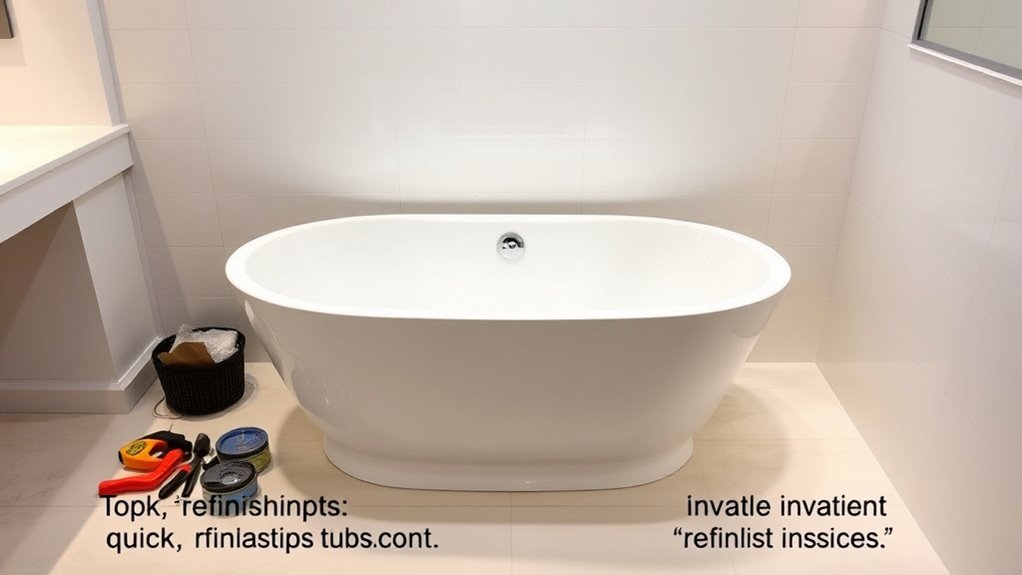
Because refinishing involves a targeted application process, it typically requires less extensive work and causes minimal disruption to your daily routine. The scope mainly involves surface preparation, cleaning, and applying a new coating, which can often be completed within a day. In contrast, replacement can involve significant installation complexity, including removal of the old tub, plumbing adjustments, and new fixture installation, often taking multiple days. The table below helps illustrate the differences:
| Aspect | Refinishing | Replacement |
|---|---|---|
| Surface Preparation | Light sanding and cleaning | Extensive removal and prep |
| Installation Complexity | Minimal, quick process | High, involves plumbing and fixtures |
| Disruption | Low, minimal daily impact | High, potential for longer inconvenience |
Refinishing keeps your routine smoother, while replacement demands more time and effort.
Resale Value and Home Investment
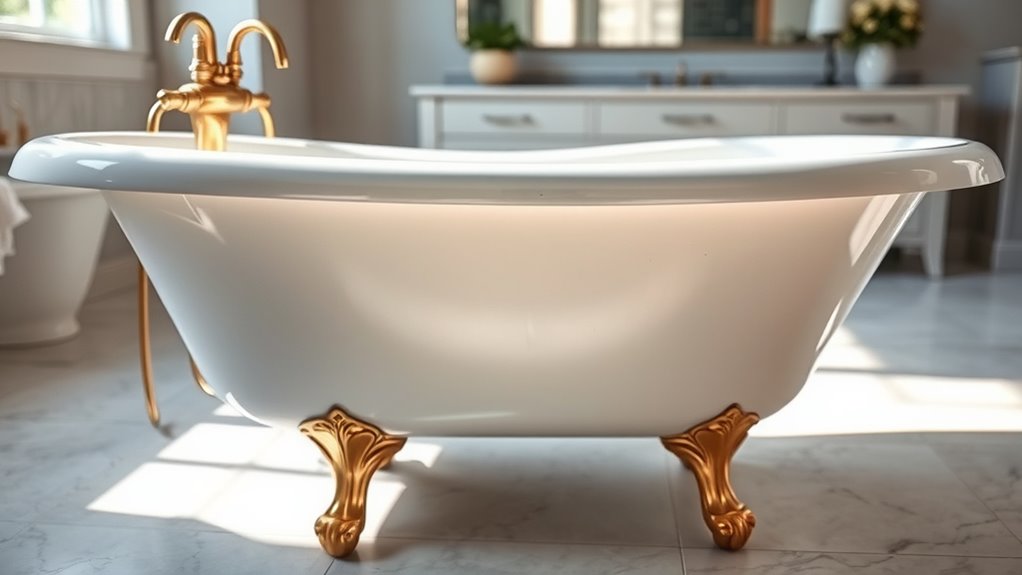
Investing in a bathtub refinishing project can boost your home’s appeal without the high costs of replacement, making it an attractive option for increasing resale value. Historically, trends show that well-maintained bathrooms enhance market value and attract buyers. Refinishing preserves the original fixtures, maintaining the home’s authentic look while updating its appearance. This can lead to a higher appraisal and quicker sale.
Refinishing your bathtub boosts home appeal and value without costly replacements.
Consider these factors:
- Cost-effectiveness compared to full replacement
- Preservation of original bathroom features
- Quick turnaround time for refinishing
- Improved aesthetic appeal
- Alignment with current market value expectations
Refinishing can be a strategic move to boost your home’s resale value by appealing to buyers seeking move-in-ready bathrooms, without the need for extensive renovations.
Long-Term Satisfaction and Expectations
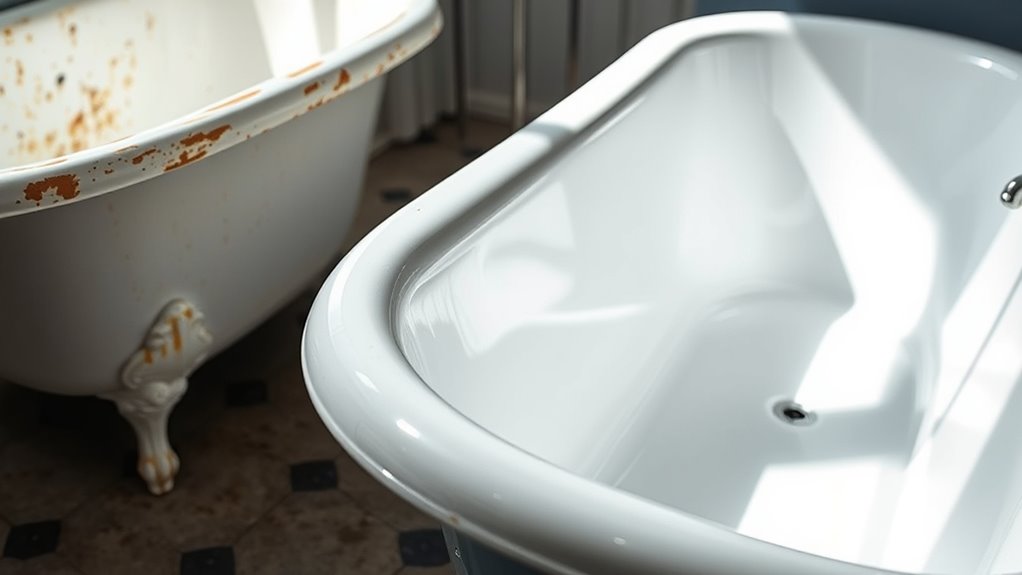
When considering long-term satisfaction, you’ll want to think about how durable your choice will be over time and whether it maintains its appearance. Your expectations for visual longevity and the amount of maintenance involved also play a big role in how happy you’ll be with your decision. Understanding these factors helps guarantee your bathroom looks great and functions well for years to come.
Durability Over Time
Over time, the durability of your bathtub depends heavily on whether you choose refinishing or replacement. With refinishing, surface wear can occur faster, especially if the material isn’t inherently durable or if proper care isn’t maintained. Replacement often offers better material durability, but it’s more invasive and costly. Consider these factors:
- Quality of the original material affects long-term resilience
- Surface wear susceptibility varies by finish type
- Regular cleaning impacts surface longevity
- Proper installation influences overall durability
- Usage frequency can accelerate aging
Refinished tubs may need touch-ups sooner, while replacements tend to hold up longer with minimal surface wear. Your expectations for durability should match the material quality and maintenance habits you’re willing to uphold over time.
Visual Longevity Expectations
The way your bathtub looks over time plays a significant role in your overall satisfaction. When considering refinishing or replacement, your expectations for visual quality and surface consistency matter. Refinishing can restore a smooth, glossy surface, but it may fade or develop imperfections more quickly than a new tub. Replacement offers a fresh, pristine look with guaranteed surface uniformity, but at a higher cost.
| Aspect | Expected Longevity |
|---|---|
| Surface Quality | Refinishing maintains visual appeal for 5-7 years; replacement lasts longer. |
| Surface Consistency | Refinishing may show slight variations over time; replacement provides uniformity indefinitely. |
Your choice impacts long-term satisfaction based on visual and surface durability.
Maintenance Requirements
Maintaining your bathtub properly is essential for ensuring long-term satisfaction, whether you choose refinishing or replacement. Regular cleaning routines help preserve the surface and prevent damage. Be mindful of product compatibility; some cleaners can harm refinished surfaces or new tubs. To keep your bathtub in top condition, consider these maintenance tips:
- Use gentle, non-abrasive cleaners
- Avoid harsh chemicals or scrubbers
- Rinse thoroughly after cleaning
- Check product labels for compatibility
- Address stains or chips promptly
Frequently Asked Questions
How Does Bathtub Refinishing Affect Indoor Air Quality?
When you refinish your bathtub, it can temporarily affect indoor air quality through airborne particles and chemical emissions. These fumes may cause breathing issues or irritation if ventilation isn’t adequate. However, using low-VOC products and ensuring proper airflow during and after the process can minimize these effects. Overall, refinishing can be safe if you follow safety guidelines, but it’s wise to stay out of the area until fumes dissipate.
Are There Specific Materials Better Suited for Refinishing?
Think of refinishing like choosing the right brush for a masterpiece; your material choice matters. You’ll find acrylic options are lightweight and easy to apply, giving a smooth finish, while porcelain durability offers a classic, long-lasting look. Selecting the right materials depends on your needs—if you want quick results, go for acrylic; if longevity matters most, porcelain is your best bet. Your decision shapes your bathroom’s future.
What Warranties Are Typically Offered on Refinished Tubs?
When considering refinished tubs, you should ask about warranty coverage and warranty duration. Most refinishing professionals offer warranties that typically last from one to three years, covering issues like peeling or chipping. You’re usually protected against manufacturing defects, but it’s important to read the fine print. This warranty gives you peace of mind, ensuring your refinished tub remains in good condition for the covered period.
Can Refinishing Be Done in a Single Day?
Refinishing a bathtub can often be completed in a single day, depending on the refinishing timeline and the surface preparation techniques used. Skilled professionals typically strip old coating, clean, and apply new finishes efficiently, minimizing downtime. However, drying and curing times are essential. If everything goes smoothly, you can enjoy your refreshed tub the same day, but it’s best to confirm the timeline with your contractor for ideal results.
How Do Local Building Codes Impact Bathtub Replacement Options?
When replacing your bathtub, local building codes substantially impact your options. You need to check for building code restrictions that might limit your choices or require specific materials. Additionally, permit requirements are essential to take into account, as failing to obtain necessary permits can cause delays or fines. Always consult your local authorities or a professional to make sure your replacement complies with all regulations, making the process smoother and legally sound.
Conclusion
Ultimately, whether you choose to refinish or replace your bathtub, think of it as planting a seed for your bathroom’s future. Refinishing is like giving your existing fixture a fresh coat of paint—quick and cost-effective—while replacement is planting a new tree, offering lasting beauty. Whichever path you take, make sure it aligns with your style, budget, and needs. Your bathroom’s transformation awaits—ready to blossom into a space you’ll love to retreat to.
